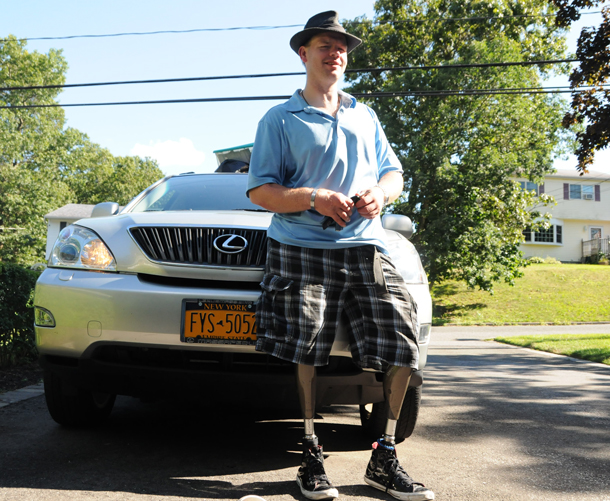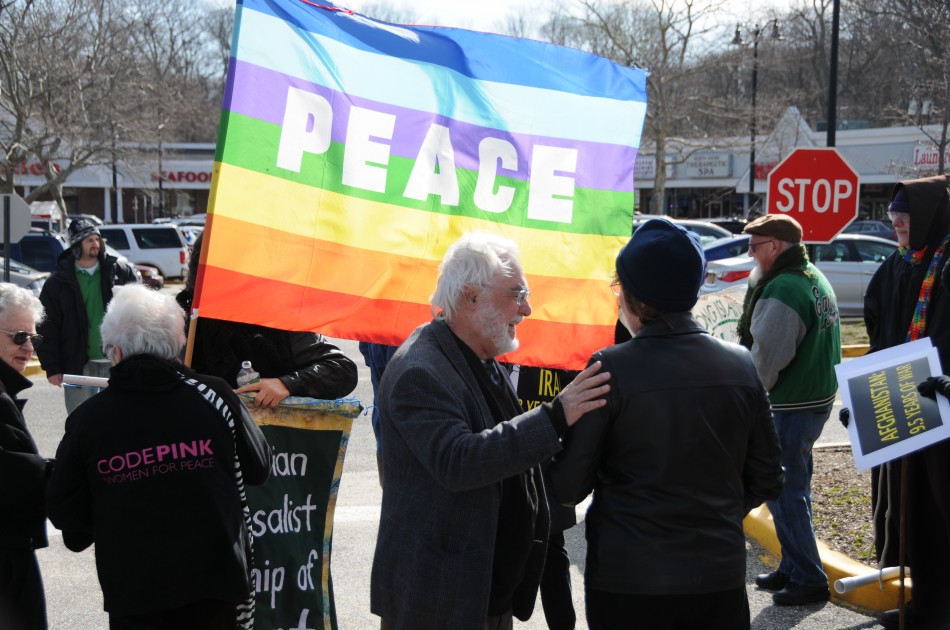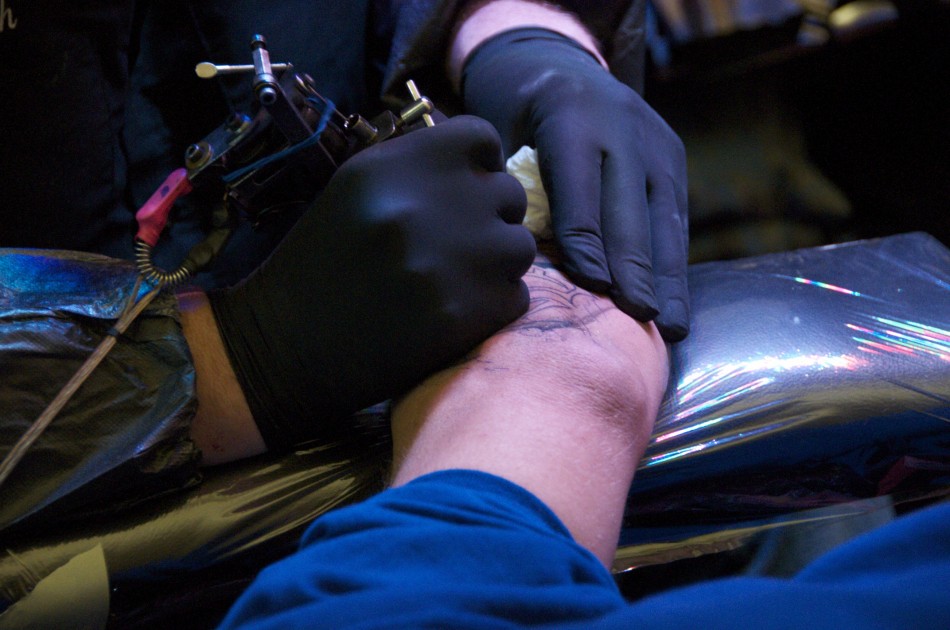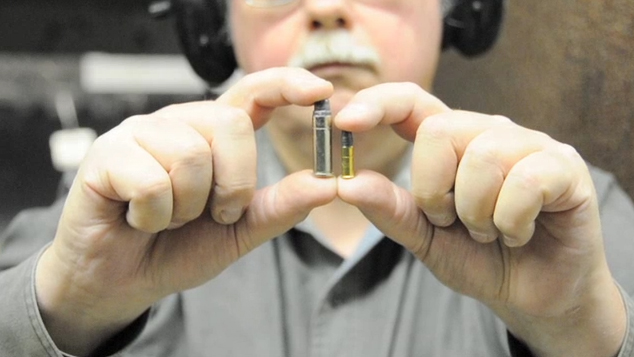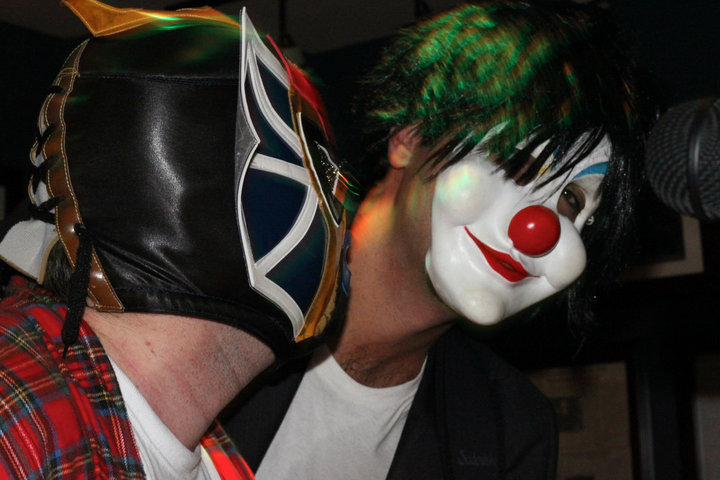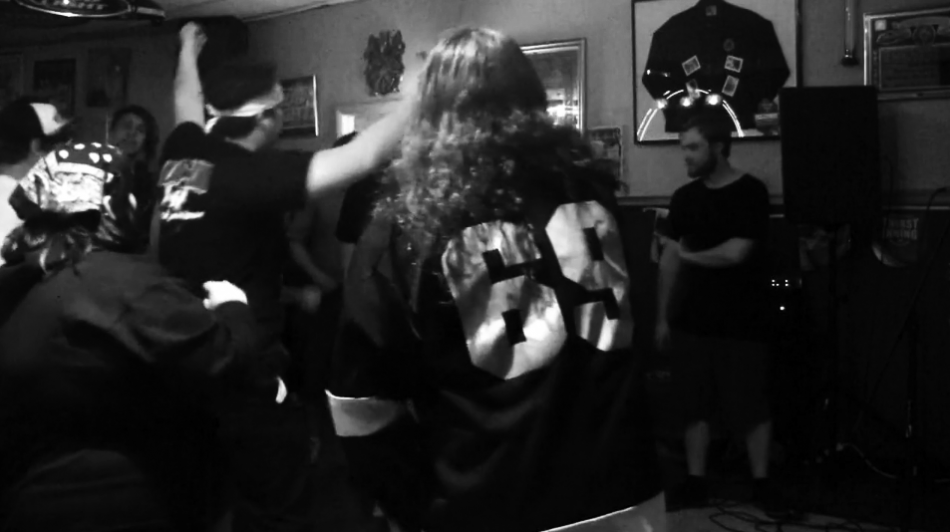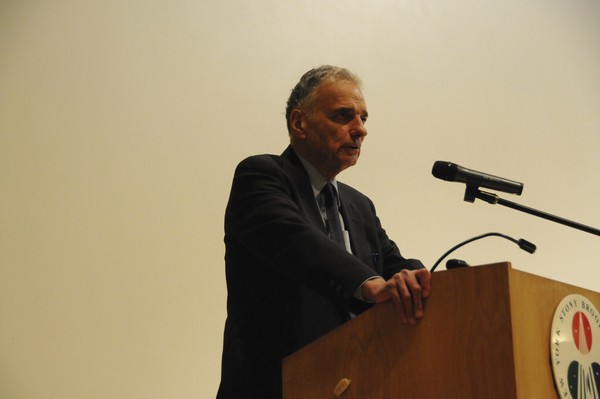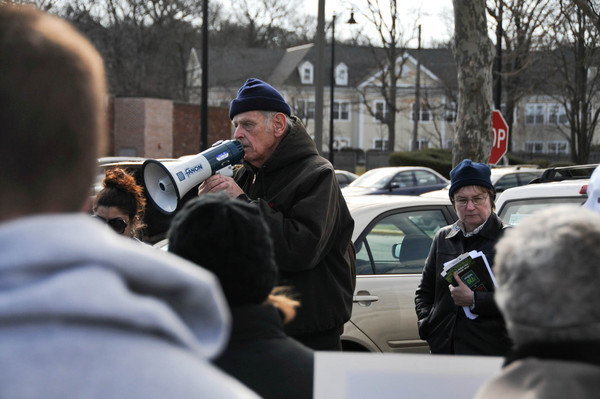Virtual reality therapy programs recreate experiences that returning veterans suffering from PTSD endured overseas, to help them readjust to civilian life. (Courtesy of University of Southern California Institute for Creative Technologies)
Screams and the explosion of weapons fire pierce the arid desert air as a procession of armored military vehicles edging through suburban Sadr City in Baghdad come under attack by a group of insurgents.
Seated inside a Humvee within the convoy is 24-year-old U.S. Army Ranger Chris Levi. A series of thunderous detonations liquefy a stack of four, 6-inch-wide copper plates, hurling large, molten slugs toward his vehicle at speeds just under a mile per second.
The explosively formed projectiles, called EFPs by the troops, tear through his Humvee’s door, slicing its engine and radio mount before eventually splitting off the vehicle’s entire front end.
Levi’s platoon sergeant and a nearby medic rush to the aid of the downed mortar-systems expert from Holbrook.
“I heard yelling about [someone] finding something, and the medic [was] crying and saying he couldn’t find it and that it was lost,” he recalls over a recent lunch. “I kind of turned my head and looked at them—and [the medic] started yelling that ‘he found it—he found it!’ He was talking about my heartbeat.”
For Levi, now 29, narrowly cheating death in Iraq in March 2008 came at a heavy cost. The EFPs claimed his legs and permanently injured his right arm, leaving him with nerve damage and traumatic brain injury. Upon returning home that same year, the infantryman was diagnosed with depression, anxiety and Post-Traumatic Stress Disorder, or PTSD.
Of the combined 2.5 million servicemen and women who fought in Iraq and are returning home by the tens and thousands from Afghanistan, 20 percent are coping with PTSD. In addition to the classic counseling methods, to better treat this steady stream of soldiers coming home from America’s longest war, veterans hospitals are increasingly offering high- and low-tech rehabilitative options, such as virtual reality (VR) and complementary and alternative medicine, such as yoga, which experts say can help vets re-acclimate to civilian life.
The goal is to avoid delaying mental health treatment—something that happened to many veterans of past wars, and thus, made it that much more difficult for them to adjust.
“We have group therapy, individual therapy, we do evidence-based treatment with prolonged exposure therapy and cognitive processing therapy,” says Dr. Robert Galak, PTSD unit manager at the Northport Veterans Affairs Medical Center, of the options currently available at the center. “We’re also bringing in some of the alternative medicine strategies that have been very successful. We try to incorporate as many different modalities into the treatment of PTSD as we can.”
“We’re looking at virtual reality exposure therapy,” he adds.
DIGITAL WAR ZONE
Used at veterans hospitals since 2009, computer-based virtual reality exposure therapy, or VR therapy, has its origins at the University of Southern California Institute for Creative Technologies (ICT).
Albert “Skip” Rizzo, associate director for medical virtual reality at ICT, tells the Press he got his inspiration for a VR therapy prototype in 2003, after watching a clip for an upcoming video game called Full Spectrum Warrior released for the Xbox gaming console. This early precursor was originally funded by the Army as a combat tactical simulation.
Adopting game elements and art assets from the Xbox video game, Rizzo’s prototype received glowing feedback, and in 2005, his team was given government funding to create better VR simulation programs for use as treatment tools for returning soldiers.
Rizzo’s programs, dubbed “Virtual Iraq” and “Virtual Afghanistan” use “virtual scenarios specifically designed to represent relevant contexts for VR exposure therapy, including Middle Eastern-themed cities and desert road environments,” he explains.
Vets suffering from PTSD navigate these digital virtual environments and relive the experiences they endured while on the real front lines, helping them deal with the disorder’s triggers head-on, and ultimately, alleviate any related symptoms.
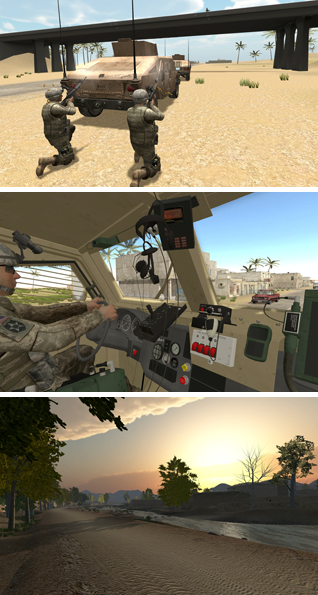 Hospitals are implementing computer-based virtual reality therapy to help soldiers suffering from Post Traumatic Stress Disorder re-acclimate to civilian life. The treatment allows soldiers to relive the experiences they went through in Iraq and Afghanistan. (Courtesy of University of Southern California Institute for Creative Technologies)
Hospitals are implementing computer-based virtual reality therapy to help soldiers suffering from Post Traumatic Stress Disorder re-acclimate to civilian life. The treatment allows soldiers to relive the experiences they went through in Iraq and Afghanistan. (Courtesy of University of Southern California Institute for Creative Technologies)
“What we’re doing is basically taking an already evidence-based treatment for PTSD exposure therapy, or prolonged exposure, and we’re delivering it with a virtual reality simulation that allows the clinician to control everything that goes on in the simulation as a way to pace the exposure in a very systematic and controlled way,” says Rizzo.
Patients who were treated with his team’s VR exposure programs in 2006 at a naval medical center at Camp Pendleton in San Diego received good results in their initial open clinical trial.
“Other groups got interested in it and we kept expanding the system and tried to make it better,” he says. “That version that we built there ended up getting distributed out to about 55 sites [across the country].”
Among those to begin using the VR software Rizzo helped pioneer is the Phobia and Trauma Clinic at Hofstra University’s Joan and Arnold Saltzman Community Services Center.
According to the clinic’s director, Dr. Mitchell Schare, research in this treatment area initially began at Hofstra in 1998 and has been used with patients struggling with phobias ranging from fear of flying to public speaking. Once implemented, Schare is confident that VR exposure treatment for use with veterans struggling with PTSD will enjoy the same success as the other VR programs already in use at the college.
“I’ve been having various people come and speak to my students, veterans themselves [and] people who treat veterans,” says Schare. “We’ve been watching all kinds of materials, some issued by the government, documentaries on Afghanistan and Iraq, so I’ve been training students and preparing them.”
“We will be absolutely offering [VR exposure therapy] as part of treatment,” he adds.
Levi was among many wounded veterans who underwent VR exposure therapy at the Walter Reed Army Medical Center in Washington, D.C., before it closed its doors in 2011 and merged with the National Naval Medical Center to form the present-day Walter Reed National Military Medical Center.
He is living, breathing proof of its success in combating PTSD.
“There was a person I know that was afraid for his life sitting in any vehicle,” he tells the Press. “They put this apparatus on his head and he was using it to watch himself walk up to a vehicle and then he would sit in [it] and would be able to stop if he wanted to without being in a [real] vehicle.”
Levi credits the program with helping him learn how to drive again after his injuries left him unable to operate a car without special hand controls.
“They had screens on all of the walls in the room that you’re in, and there’s the cab of this little pickup truck, and there’s no back on it and there’s no front on it,” he says, recalling his turn in the VR machine.
“It’s just the cab of the pickup truck and you have the seat and the hand control,” he continues. “You go on a highway, you go into the town, and you learn how to drive—it’s all virtual and it’s replicating reality.”
DOWNWARD DOG
There are approximately 138,000 veterans living on the Island, second only to San Diego in the percentage of vets among citizens, according to local veterans advocates. Roughly 5,000 LI residents served in Iraq and in Afghanistan.
With U.S. troop withdrawal from Iraq last year, LI is now undergoing an influx of Afghanistan vets, with complete drawdown expected next year.
With such a significant sea change in LI’s veteran population, the Northport VA has not only been researching newer technology, such as VR therapy, in treating newly returning vets, but also New Age treatments, such as yoga, for both new and old.
“People are looking for this [treatment], so the veterans are very welcoming of it,” says Richelle Rapaport, a clinical nurse specialist in psych mental health and a board-certified advanced practice holistic nurse at the VA.
Rapaport, who’s been with the VA since 1988, received grant funding that trained 200 VA staff members in Tai Chi, Reiki Relaxation, yoga, guided imagery, reflexology, clinical meditation and aroma therapy two years ago.
Despite their tough and combat-hardened perception, Rapaport says it’s the young vets, especially the men, who do better with these physical modalities combined with elements of meditation and Tai Chi. Overall, it helps both servicemen and women “settle down, focus their brains and reduce their reactivity,” she explains.
“You can be the toughest person in the world, but yoga could still knock you out, man,” admits Levi. “It’s not the easiest thing in the world and a lot of these guys…have no range of motion at all, and then they get injured, and they have a bad back or they have a prosthetic on one of their legs. [Their] range of motion is what’s stopping them from being able to maneuver that prosthetic properly. With yoga, you can control your body and do stretches and breathing. It’s relaxing and it’s fulfilling.”
THE WAR WITHIN
Even with this new wave of treatment options, however, experts agree that returning veterans may still find difficulty adjusting to civilian life, whether because of trouble at home or school, unemployment, or drug and alcohol abuse.
In the same high-tech vein as the VR therapy, VA officials are now also using online and texting services as a means of connecting with soldiers who served during Operation Iraqi Freedom and Operation Enduring Freedom in Afghanistan.
“More and more younger service members are coming home and our texting program is…becoming much more popular,” says Dr. Caitlin Thompson, deputy director of the Canandaigua VA’s Suicide Prevention Program in upstate New York. “So, the use of new technology is essential, and developing ways to both reach people and to intervene with folks with using this new technology is absolutely huge.”
She says suicide remains an unfortunate reality among PTSD patients. Of the approximately 32,000 suicides per year in the United States, 20 percent are veterans, and each day 18 suicide-related deaths are committed by veterans, according to the VA National Mental Health Service.
The veterans’ crisis line is one of the last lines of defense in helping to subdue this dark trend gripping veterans.
“That’s kind of the linchpin for suicide prevention efforts with the VA,” says Thompson. “In general, it’s known you need to get people out of the immediate crisis, and then you need to follow up with them over time so that they can get the treatment that they need and they can get the support that they need because [it] works.
“We get calls from people who are waking up from nightmares in the middle of the night and just need to talk with somebody, and that runs to people who are standing on the bridge and are ready to jump.”
MODERN WARFARE
PTSD is hardly a new phenomenon, but it wasn’t until 1980 that the disorder was even recognized as a medical condition.
Older veterans had therefore potentially suffered for several decades without getting the help they so desperately needed, according to John Javis, chairperson of Veterans Health Alliance of Long Island, a nonprofit that works with veterans, their families and collaborates with other vet groups, including the Northport VA.
“In World War I we called [PTSD] ‘shell shock’—some of the old black and white footage of soldiers after the war show people walking around these mental hospitals just shaking because of being exposed to artillery and being in trenches,” he says. “In World War Two it was known as ‘combat fatigue.’ In other words, a Vietnam veteran [who], let’s say, came home in 1968 with PTSD, well, the field didn’t even really start to name it until 1980.”
Joe Messana understands the difficulties Vietnam veterans faced firsthand. The Hicksville resident enlisted into the military during the fall of 1967 and received orders to deploy to Vietnam the following year with the 90th Replacement Battalion, stationed in Long Binh Post—the U.S. Army’s headquarters.
“These poor guys from World War II, Vietnam and Korea who came home, they didn’t get [treatment for] PTSD,” he explains. “There was no understanding, and they were probably put in a mental institute immediately because they weren’t getting used to civilian life. And this is what happens: you can’t get a guy that’s been in combat in 100-degree weather in the jungles of Vietnam and all of a sudden have him go to New York City on 42nd Street.”
He suggests the same holds true for the younger generation of combat veterans returning home from Iraq and Afghanistan.
“When we were in the service you’d hear about constant combat, the sounds of the jets and the sounding of war,” he says. “When we were there it was one year that we were in combat duty and when we came home there was no such thing as an [off] switch. These kids are coming home and they’re confused, and don’t forget…they’re coming back from a war and some [served multiple tours], there’s no such thing as an [off] switch.”
While the nature of conflict in current wars and those of years past may differ, Galak says the harsh reality of modern combat still takes its toll.
“The changes take place with the change in warfare in Vietnam and Iraq and Afghanistan,” says Galak. “There are no front lines and no rear lines, so you’re constantly under threat of sniper fire and improvised explosive devices. It’s very difficult to tell friendlies from the enemy—they’re under the constant threat of combat 100 percent [of the time].”
There are endless examples of such scenarios leaving permanent, invisible scars.
Levi, the corporal, recalls a flatbed truck carrying eight pipes—each containing a powerful Katyusha rocket—exploding in Eastern Baghdad outside one of the four largest forward-operating bases.
“It was probably booby-trapped, and when the people jumped on they initiated the explosives,” he says. “The amount of damage they did in that confined area was severely intense so…the 80 Iraqi soldiers that were standing around watching this go on were injured by random pieces of shrapnel. Fifteen people were vaporized.”
Levi recalls the only person in the vicinity who was capable of treating the injured was an 18-year-old medic who was new to combat.
“This medic had to [decide] if certain soldiers’ injuries were severe enough where they wouldn’t make it…to the Iraqi hospital, which was about one kilometer away,” he continues.
“In those moments he had to decide how to ration supplies among the injured, and who was going to live or die,” adds Levi. “Their lives were in his hands, and afterwards he was covered in blood and we had to hose him off with water and soap.”
Christopher Levi, a 29-year-old U.S. Army Ranger from Holbrook, stands with the help of prosthetic legs in front of his Lexus SUV that he re-learned how to drive with the help of virtual reality exposure therapy.
Even with all of the outreach, medical advancements and new treatment options for patients suffering PTSD, the stigma associated with seeking mental health treatment can still dissuade veterans from getting the help that they need.
“There’s still the concern about stigma, and the VA is trying to work to eliminate the stigma of mental health,” says Joe Sledge, Northport VA spokesman.
“Everyone who goes to war comes back affected by that experience,” he says. “They could potentially save themselves years of unhappiness by getting the treatment early. The earlier that they come in, the better off they’ll be.”
Tom Ronayne, director of Suffolk County Veterans’ Services, an organization that among other things, assists veterans with processing claims for benefits, also recognizes the challenges this stigma poses to mental health treatment. Ultimately, he says, veterans are doing themselves a disservice by not seeking help for fear of being ostracized.
“The de-stigmatization of these mental health issues is going to be a game-changer,” says Ronayne. “When we sent them away, they were okay. When they came home, they’re broken.
“We have an obligation to make sure that they’re not only well cared for, but that we support them in any way possible, so that we can ensure that their prognosis going forward is that they’ll be able to move beyond their PTSD,” he adds.
Refusing to allow his injuries to get in the way of his career goals, Levi began working at American Portfolios Financial Services less than a year ago. This past June, he enrolled at Long Island University, where he’s studying business with plans to continue his education during the fall semester.
“I’d like to be a financial advisor,” says Levi. “I’ve already learned a lot [at American Portfolios] and I’ll learn even more at LIU Post.
“Despite all I’ve been through, I know that I can make it if I just go for it.”
See the original article here.


